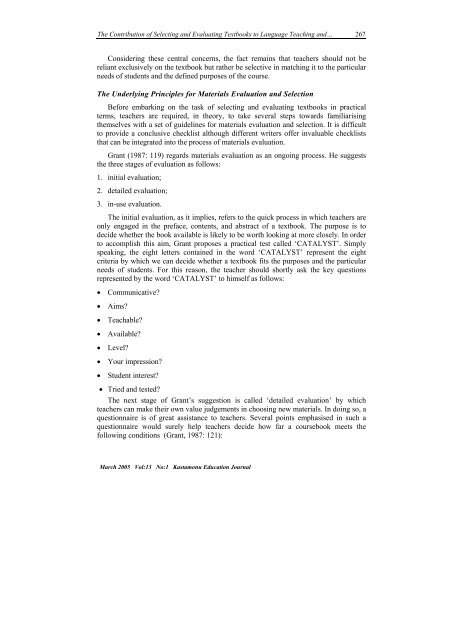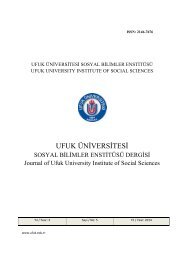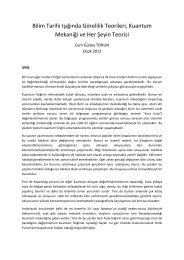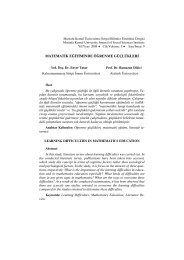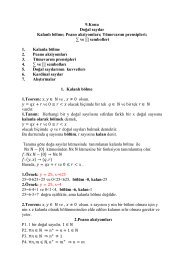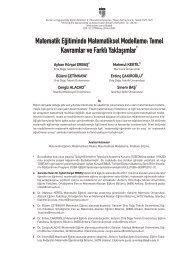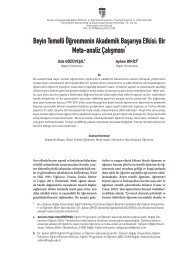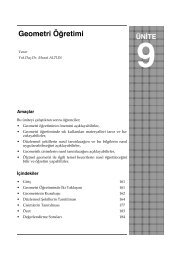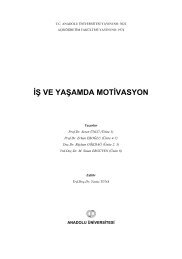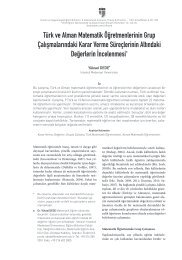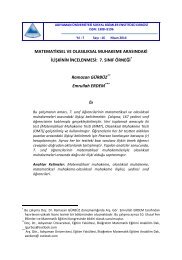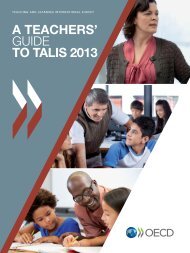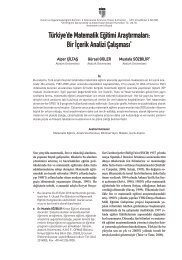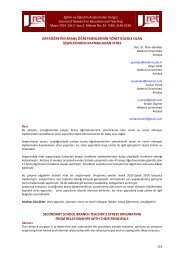- Page 1 and 2:
Gazi Üniversitesi Kastamonu Eğiti
- Page 3 and 4:
Mart 2005 Cilt:13 No:1 Kastamonu E
- Page 5 and 6:
Öğretmenlik Uygulamalarında Mikr
- Page 7 and 8:
Öğretmenlik Uygulamalarında Mikr
- Page 9 and 10:
Öğretmenlik Uygulamalarında Mikr
- Page 11 and 12:
Öğretmenlik Uygulamalarında Mikr
- Page 13 and 14:
Mart 2005 Cilt:13 No:1 Kastamonu E
- Page 15 and 16:
Sosyal Risk Altındaki Çocuklar, G
- Page 17 and 18:
Sosyal Risk Altındaki Çocuklar, G
- Page 19 and 20:
Sosyal Risk Altındaki Çocuklar, G
- Page 21 and 22:
Sosyal Risk Altındaki Çocuklar, G
- Page 23 and 24:
Sosyal Risk Altındaki Çocuklar, G
- Page 25 and 26:
Mart 2005 Cilt:13 No:1 Kastamonu E
- Page 27 and 28:
Okulöncesi Eğitim Programlarına
- Page 29 and 30:
Okulöncesi Eğitim Programlarına
- Page 31 and 32:
Okulöncesi Eğitim Programlarına
- Page 33 and 34:
Mart 2005 Cilt:13 No:1 Kastamonu E
- Page 35 and 36:
Davranış Kültürünün Turizme Y
- Page 37 and 38:
Davranış Kültürünün Turizme Y
- Page 39 and 40:
Davranış Kültürünün Turizme Y
- Page 41 and 42:
Davranış Kültürünün Turizme Y
- Page 43 and 44:
Mart 2005 Cilt:13 No:1 Kastamonu E
- Page 45 and 46:
İlköğretimde Sosyal Becerilerin
- Page 47 and 48:
İlköğretimde Sosyal Becerilerin
- Page 49 and 50:
İlköğretimde Sosyal Becerilerin
- Page 51 and 52:
İlköğretimde Sosyal Becerilerin
- Page 53 and 54:
İlköğretimde Sosyal Becerilerin
- Page 55 and 56:
İlköğretimde Sosyal Becerilerin
- Page 57 and 58:
Mart 2005 Cilt:13 No:1 Kastamonu E
- Page 59 and 60:
Küreselleşme, Bilgi Toplumu ve E
- Page 61 and 62:
Küreselleşme, Bilgi Toplumu ve E
- Page 63 and 64:
Küreselleşme, Bilgi Toplumu ve E
- Page 65 and 66:
Küreselleşme, Bilgi Toplumu ve E
- Page 67 and 68:
Küreselleşme, Bilgi Toplumu ve E
- Page 69 and 70:
Mart 2005 Cilt:13 No:1 Kastamonu E
- Page 71 and 72:
Lise Düzeyinde Öğrenim Gören Ö
- Page 73 and 74:
Lise Düzeyinde Öğrenim Gören Ö
- Page 75 and 76:
Lise Düzeyinde Öğrenim Gören Ö
- Page 77 and 78:
Lise Düzeyinde Öğrenim Gören Ö
- Page 79 and 80:
Lise Düzeyinde Öğrenim Gören Ö
- Page 81 and 82:
Lise Düzeyinde Öğrenim Gören Ö
- Page 83 and 84:
Mart 2005 Cilt:13 No:1 Kastamonu E
- Page 85 and 86:
İlköğretim Okullarında Türkçe
- Page 87 and 88:
İlköğretim Okullarında Türkçe
- Page 89 and 90:
İlköğretim Okullarında Türkçe
- Page 91 and 92:
İlköğretim Okullarında Türkçe
- Page 93 and 94:
İlköğretim Okullarında Türkçe
- Page 95 and 96:
Mart 2005 Cilt:13 No:1 Kastamonu E
- Page 97 and 98:
Öğretmen Adaylarının Öz-Yeterl
- Page 99 and 100:
Öğretmen Adaylarının Öz-Yeterl
- Page 101 and 102:
Öğretmen Adaylarının Öz-Yeterl
- Page 103 and 104:
Öğretmen Adaylarının Öz-Yeterl
- Page 105 and 106:
Mart 2005 Cilt:13 No:1 Kastamonu E
- Page 107 and 108:
Fen Eğitiminde İlköğretim 6. S
- Page 109 and 110:
Fen Eğitiminde İlköğretim 6. S
- Page 111 and 112:
Fen Eğitiminde İlköğretim 6. S
- Page 113 and 114:
Fen Eğitiminde İlköğretim 6. S
- Page 115 and 116:
Fen Eğitiminde İlköğretim 6. S
- Page 117 and 118:
Fen Eğitiminde İlköğretim 6. S
- Page 119 and 120:
Mart 2005 Cilt:13 No:1 Kastamonu E
- Page 121 and 122:
İlköğretim Matematik Öğretmenl
- Page 123 and 124:
İlköğretim Matematik Öğretmenl
- Page 125 and 126:
İlköğretim Matematik Öğretmenl
- Page 127 and 128:
İlköğretim Matematik Öğretmenl
- Page 129 and 130:
İlköğretim Matematik Öğretmenl
- Page 131 and 132:
Mart 2005 Cilt:13 No:1 Kastamonu E
- Page 133 and 134:
Matematik Öğretiminde Kendini Ger
- Page 135 and 136:
Matematik Öğretiminde Kendini Ger
- Page 137 and 138:
Matematik Öğretiminde Kendini Ger
- Page 139 and 140:
Matematik Öğretiminde Kendini Ger
- Page 141 and 142:
Mart 2005 Cilt:13 No:1 Kastamonu E
- Page 143 and 144:
Değişken Kavramı Üzerine 141 Bu
- Page 145 and 146:
Değişken Kavramı Üzerine 143 5.
- Page 147 and 148:
Değişken Kavramı Üzerine 145 Us
- Page 149 and 150:
Değişken Kavramı Üzerine 147 ge
- Page 151 and 152:
Mart 2005 Cilt:13 No:1 Kastamonu E
- Page 153 and 154:
Taşköprü Fidanlığında (Kastam
- Page 155 and 156:
Taşköprü Fidanlığında (Kastam
- Page 157 and 158:
Taşköprü Fidanlığında (Kastam
- Page 159 and 160:
Taşköprü Fidanlığında (Kastam
- Page 161 and 162:
Mart 2005 Cilt:13 No:1 Kastamonu E
- Page 163 and 164:
Arıtılmış Atık Suların Bazı
- Page 165 and 166:
Mart 2005 Cilt:13 No:1 Kastamonu E
- Page 167 and 168:
Enver Paşa’nın Hayatı ve İngi
- Page 169 and 170:
Enver Paşa’nın Hayatı ve İngi
- Page 171 and 172:
Enver Paşa’nın Hayatı ve İngi
- Page 173 and 174:
Enver Paşa’nın Hayatı ve İngi
- Page 175 and 176:
Enver Paşa’nın Hayatı ve İngi
- Page 177 and 178:
Enver Paşa’nın Hayatı ve İngi
- Page 179 and 180:
Enver Paşa’nın Hayatı ve İngi
- Page 181 and 182:
Enver Paşa’nın Hayatı ve İngi
- Page 183 and 184:
Mart 2005 Cilt:13 No:1 Kastamonu E
- Page 185 and 186:
Taşköprü Çevresindeki Köy Mesk
- Page 187 and 188:
Taşköprü Çevresindeki Köy Mesk
- Page 189 and 190:
Taşköprü Çevresindeki Köy Mesk
- Page 191 and 192:
Taşköprü Çevresindeki Köy Mesk
- Page 193 and 194:
Taşköprü Çevresindeki Köy Mesk
- Page 195 and 196:
Mart 2005 Cilt:13 No:1 Kastamonu E
- Page 197 and 198:
Hızlı Kentleşme Sürecinde Çevr
- Page 199 and 200:
Hızlı Kentleşme Sürecinde Çevr
- Page 201 and 202:
Hızlı Kentleşme Sürecinde Çevr
- Page 203 and 204:
Hızlı Kentleşme Sürecinde Çevr
- Page 205 and 206:
Hızlı Kentleşme Sürecinde Çevr
- Page 207 and 208:
Hızlı Kentleşme Sürecinde Çevr
- Page 209 and 210:
Mart 2005 Cilt:13 No:1 Kastamonu E
- Page 211 and 212:
Ankara Savaşı’na Kadar Osmanlı
- Page 213 and 214:
Ankara Savaşı’na Kadar Osmanlı
- Page 215 and 216:
Ankara Savaşı’na Kadar Osmanlı
- Page 217 and 218: Ankara Savaşı’na Kadar Osmanlı
- Page 219 and 220: Ankara Savaşı’na Kadar Osmanlı
- Page 221 and 222: Ankara Savaşı’na Kadar Osmanlı
- Page 223 and 224: Ankara Savaşı’na Kadar Osmanlı
- Page 225 and 226: Mart 2005 Cilt:13 No:1 Kastamonu E
- Page 227 and 228: Atatürk’ün Kastamonu Gezisi ve
- Page 229 and 230: Atatürk’ün Kastamonu Gezisi ve
- Page 231 and 232: Atatürk’ün Kastamonu Gezisi ve
- Page 233 and 234: Atatürk’ün Kastamonu Gezisi ve
- Page 235 and 236: Mart 2005 Cilt:13 No:1 Kastamonu E
- Page 237 and 238: Türkistan’da Açılan Rus Eğiti
- Page 239 and 240: Türkistan’da Açılan Rus Eğiti
- Page 241 and 242: Türkistan’da Açılan Rus Eğiti
- Page 243 and 244: Mart 2005 Cilt:13 No:1 Kastamonu E
- Page 245 and 246: Konya Şehir Yerleşmesinin Selçuk
- Page 247 and 248: Konya Şehir Yerleşmesinin Selçuk
- Page 249 and 250: Konya Şehir Yerleşmesinin Selçuk
- Page 251 and 252: Konya Şehir Yerleşmesinin Selçuk
- Page 253 and 254: Konya Şehir Yerleşmesinin Selçuk
- Page 255 and 256: Konya Şehir Yerleşmesinin Selçuk
- Page 257 and 258: Mart 2005 Cilt:13 No:1 Kastamonu E
- Page 259 and 260: Learning English Through Cooperatio
- Page 261 and 262: Learning English Through Cooperatio
- Page 263 and 264: Learning English Through Cooperatio
- Page 265 and 266: Learning English Through Cooperatio
- Page 267: Mart 2005 Cilt:13 No:1 Kastamonu E
- Page 271 and 272: The Contribution of Selecting and E
- Page 273 and 274: The Contribution of Selecting and E
- Page 275 and 276: Mart 2005 Cilt:13 No:1 Kastamonu E
- Page 277 and 278: Yapısına Göre İki Halk Hikâyes
- Page 279 and 280: Yapısına Göre İki Halk Hikâyes
- Page 281 and 282: Yapısına Göre İki Halk Hikâyes
- Page 283 and 284: Yapısına Göre İki Halk Hikâyes
- Page 285 and 286: Yapısına Göre İki Halk Hikâyes
- Page 287 and 288: Yapısına Göre İki Halk Hikâyes
- Page 289 and 290: Mart 2005 Cilt:13 No:1 Kastamonu E
- Page 291 and 292: Preparing a More Brain Compatible C
- Page 293 and 294: Preparing a More Brain Compatible C
- Page 295 and 296: Preparing a More Brain Compatible C
- Page 297 and 298: Preparing a More Brain Compatible C
- Page 299 and 300: Preparing a More Brain Compatible C
- Page 301 and 302: Mart 2005 Cilt:13 No:1 Kastamonu E
- Page 303 and 304: Lise Düzeyindeki Sedanter Erkekler
- Page 305 and 306: Lise Düzeyindeki Sedanter Erkekler
- Page 307 and 308: Lise Düzeyindeki Sedanter Erkekler
- Page 309 and 310: Lise Düzeyindeki Sedanter Erkekler
- Page 311 and 312: Lise Düzeyindeki Sedanter Erkekler
- Page 313 and 314: YAZIM KURALLARI VE YAYIN İLKELERİ


